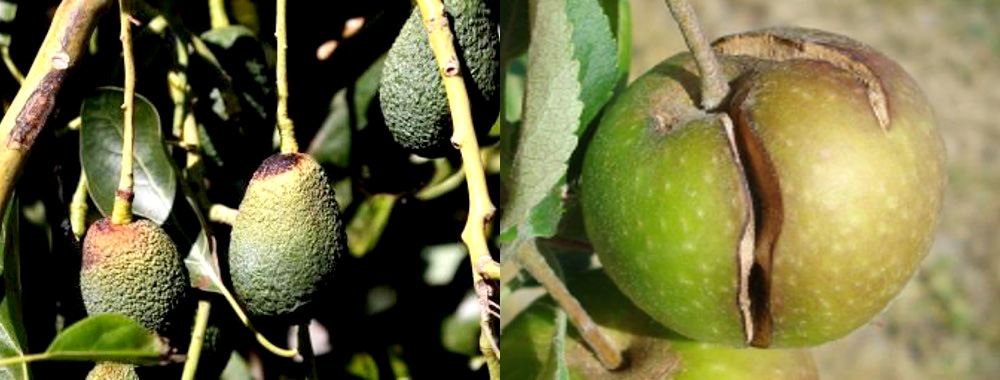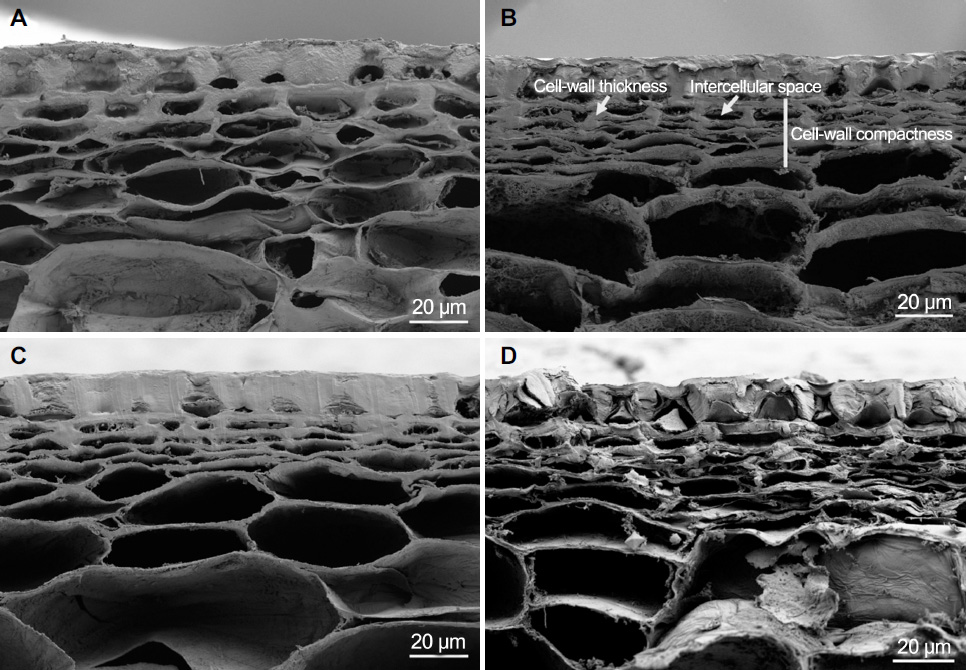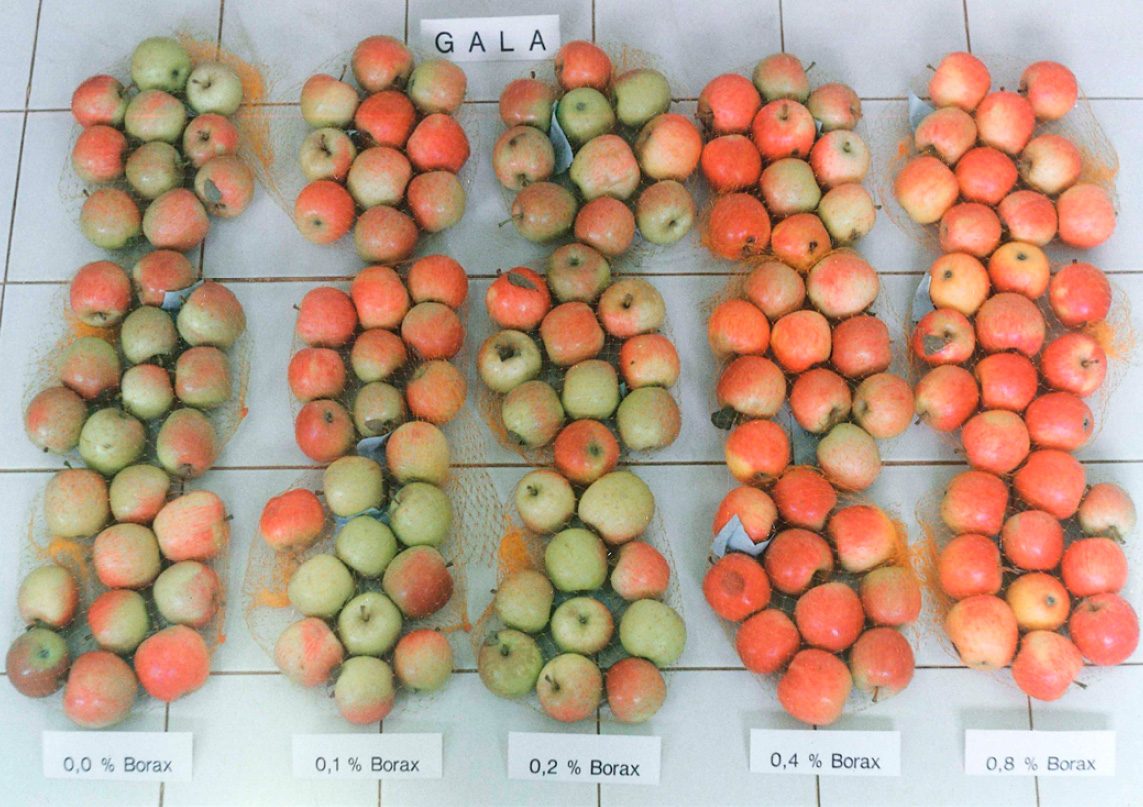by: Fabiano Silvestrin and Eduardo Cézar Medeiros Saldanha
Boron (B) is an essential micronutrient for the growth and development of plants and is vital to ensure the quality of fruit. In fruit trees, the flowering and fruiting stages are severely impacted by boron deficiency. In many growing regions—including tropical and temperate zones—boron deficiency has been reported as the most common nutrient deficiency in crops. Boron deficiency symptoms in fruit includes dryness and irregular internal (pulp) or external shape.
Climatic conditions where there is a severe reduction in water supply (droughts) are typically the initial condition for the occurrence of this deficiency. Small, round, water-soaked spots can be observed throughout the pulp as well as brown tissue usually occurring closer to the center of the fruit than to the skin. As tissue deterioration occurs, the fruit tends to deform and may also have an irregular appearance.
Fruit drying is more likely to occur if boron deficiency occurs early in the growing season which results in irregular depressions that appear as the fruit ripens. Raised brown or reddish spots may also occur. In apples, boron deficiency symptoms can often be confused with calcium (Ca) deficiency. Table 1 shows the differences between the manifestations of calcium and boron nutritional deficiencies.
Table 1: Comparison between boron and calcium deficiency symptoms in fruits
| Boron |
Calcium |
| Brown tissue near the nucleus |
Brown tissue closest to the bark |
| Cracks may occur in the fruit |
No cracks |
| Symptoms do not worsen post-harvest |
Symptoms usually increase post-harvest |
Source: Dart, J. 2004.
Boron deficiency can have a severe impact on fruit quality and yield, even when there are only mild to moderate foliar symptoms.
Figure 1: External necrosis and cracks in fruits, associated with boron deficiency

Photo: Pawel Wójcik
Boron deficiency affects the growth and productivity of citrus plants which is characterized by the appearance of “hard fruit," where the fruit becomes hardened and dry due to the coalescence of dead tissues. Premature fall of young fruits may also occur. The apple tree has been identified as a species with a high demand for boron. In deficiency conditions, the plants present reduced size, fruits become deformed, and there is a lot of cracking, presenting low levels of soluble solids (brix).
Table 2: Symptoms of boron deficiency in different fruit species
| Fruit species |
Boron deficiency symptom |
| Plum |
Multiple branching significantly reduced fruit set, brown spots on fruits |
| Apricot |
Corrosion, skin discoloration, cracking, and crusting |
| Apple |
Corrosion, skin discoloration, cracking, and crusting |
| Almond |
The flowers fall off and the nuts abort or become sticky |
| Strawberry |
Pale chlorotic skin of fruit, cracking and death |
| Pistachio |
Fruiting decreases and deformed nuts increase |
| Pear |
Flower decay, pitting, internal drying, and bark cankers |
| Grapes |
Cracks in fruit |
Source: Dar, GA. 2017.
Boron nutrition and fruit shelf life
The nutritional balance in fruit plants is a key factor in the post-harvest quality of fruits. Boron is a fundamental micronutrient due to its role in the formation of cell walls which help maintain the firmness of fruits. Its deficiency in orchards results in limitations with reduced productivity and fruit quality. Boron deficiency also reduces the rate of pollen germination and the growth of pollen tubes, which consequently causes the development of malformed fruits, deteriorating fruit quality.
A study conducted by Indian researchers (Table 3) evaluated dragon fruit in sandy soil with low organic matter content. Applying boron via sprayed solution seven days after the emission of flower buds showed results in some variables related to fruit quality.
Table 3: Influence of boron application on the quality of dragon fruits
B
(mg/l) |
Pollen germination
(%) |
Fruit weight
(g) |
Pulp firmness
(N) |
| 0.0 |
39.1e |
198f |
2.38c |
| 100 |
48.7c |
221de |
2.43c |
| 200 |
54.3b |
257b |
2.48c |
| 300 |
68.3a |
274a |
2.74a |
| 400 |
47.3c |
246c |
2.65ab |
Mean values followed by the same letter in each column show non-significant difference at P < 0.05.
Source: Sahu A, et al. 2022.
Spraying with 300 mg/l of boron resulted in the highest average values for pollen germination, fruit weight, and pulp firmness. Applications directed at the flowering stage contribute to increasing fruit quality, and especially shelf life, since pulp firmness was increased. Increasing fruit firmness reduces weight loss and the percentage of deterioration due to rot. Boron also helps maintain the integrity of cell membrane structures and can act in the activation of enzymes with antioxidant activity—preventing internal browning of fruits and their consequent degradation.
Boron and calcium generally have similar absorption, translocation, and physiological roles in crop nutrition. Strength, cell wall thickness, and tissue firmness largely depend on sufficient amounts of these nutrients, mainly forming the structural polysaccharides of plant cell walls (middle lamella pectins). In apple fruits, low levels of boron and calcium can cause premature softening, in addition to the incidence of physiological disorders such as internal decay, accelerated respiration, ethylene production, and deterioration. In addition, boron deficiency in fruits results in sensitivity to sunburn, cracking, and rot, as well as a short shelf life.
One of the most important factors in post-harvest quality is firmness, which can maintain fruit quality and extend its shelf life by increasing cell wall thickness. Boron, calcium, and B + Ca can alter these properties. Korean researchers conducted a study to determine the effects of foliar spraying of these nutrients—applied alone or in combination—on the postharvest characteristics and qualities of cherry tomatoes at the ripening stage. The results showed an increase in cell wall thickness depending on the treatments used: Control (26.1 µm), boron (28.15 µm), calcium (27.84 µm), and calcium + boron (29.84 µm). The results indicated that foliar spraying with B, Ca, and B + Ca significantly increased cell wall thickness (Figure 2). This study also observed that the treatments where calcium and boron were applied presented reduced respiration rates in relation to the control treatment. Fruits that have a high respiratory rate tend to deteriorate quickly, while fruits that respire slowly can be stored for longer periods.
Figure 2: Images of the cell walls of cherry tomato fruits scanned with electron microscope technique.
A: Control | B: Boron | C: Calcium | D: Boron + Calcium

Source: Islam, et al. 2016.
Another important effect of boron in fruit trees is associated with the transport of photoassimilates originating from the photosynthetic process of plants. It can be observed in a study conducted by researchers from the Brazilian Agricultural Research Corporation (EMBRAPA – Temperate Climate). Evaluating foliar applications of Solubor® (borax – sodium octaborate) in different concentrations on apple trees of the Gala cultivar. Three foliar applications were carried out starting four weeks after full flowering, with a 30-day interval between applications. The researchers observed that the application of boron promoted early fruit ripening, in a period that varied from 7-12 days, with a clear and noticeable influence on fruit color (Figure 3).
Figure 3: Apple fruit subjected to foliar application of Solubor borax - sodium octaborate) in different concentrations

Source: Nachtigall e Czermainski. 2014.
Borate fertilization management
Boron applications should be carried out after identifying the need, using tools to assess soil fertility and crop nutritional status. These techniques will help define the agronomic criteria for recommended doses. The application times should be adjusted in such a way as to meet the boron needs of the vegetative and reproductive phases, the latter being the most demanding for crops.
Special attention should be given to boron applications in soils with a sandy texture (˂ 15% clay), as the retention capacity of this nutrient is lower, which may result in a reduction in the soluble content of boron in the soil solution. In these soils, the doses should be divided to maximize fertilization efficiency and plant uptake. The frequency of applications will also depend on the fertilization program to be used in the crop. Soil applications can be complemented by foliar applications, especially in periods of high demand for boron, such as the flowering and fruit formation period.
Choosing the source is a very important step in boron nutrition. Fertilizers that guarantee a total and gradual supply of boron, such as Granubor®, ensure a continuous supply of nutrients throughout the cycle. Foliar supplements can be carried out with Solubor e Solubor Flow.
References
- Dart J. 2004. Boron deficiency (cork) in pome fruits. Agfact H4.AC.2, second eds.
- Dar GA. 2017. Impact of boron nutrition in fruit crops. Int J Curr Microbiol App Sci. 6(12):4145-4155.
- Islam MZ, Mele MA, Baek JP, Kang, H. 2016. Cherry Tomato Qualities Affected by Foliar Spraying with Boron and Calcium. Hortic Environ Biotechnol.
- Nachtigall GR, Czermainski ABC. 2014. Efeito da Aplicação de Boro Via Foliar na Qualidade e na Colheita de Frutos de Macieira. Comunicado Técnico 164. Embrapa.
- Sahu A, et al. 2022. Foliar feeding of boron influencing biochemical attributes and enzyme activity in dragon fruit (Selenicereus monacanthus). Notulae Botanicae Horti Agrobotanici.
Resources